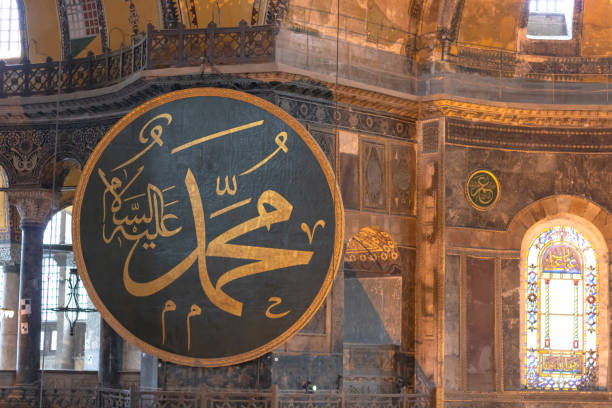
Arabic Calligraphy is an art form that has a spiritual touch. More than just writing words, it’s a sacred dance of pen and faith. Each stroke whispers prayers and verses, echoing the divine towards Allah. Looking at its history is a journey into Islamic civilization, tracing the growth of a medium that went beyond just entertainment.
The Early Strokes: From Revelation to Revelation
The Islamic story of calligraphy starts with the essence of the religion – the revelation of the Quran to Prophet Muhammad (صلى الله عليه وسلم). While not directly called a visual art, the Quran emphasizes the value of the written word, calling it a miraculous sign and guidance. This respect for writing established the growth of calligraphy in the following centuries.
In the early days of Islam, writing was a practical affair – a means of recording the revelation and setting it to paper for sharing and memorization. The angular Kufic script emerged as the predominant style, likely adapted from existing Arabic and Syrian scripts. While legibility and function were prioritized, the very act of inscribing the holy words was considered sacred.
As Islam expanded into formerly Persian and Byzantine territories, exposure to local artistic tastes began influencing Islamic aesthetics. What was once stern and functional evolved into something more refined and ornamental. Kufic scripts became more intricate and rhythmic, dance-like in their geometric harmony. By the 9th century, calligraphy began its transformation from mere handwriting into a revered art form.
The Script Takes Shape: Kufic, the First Flourish
One early calligraphic style was Kufic. With angular, geometric forms and horizontal stress, Kufic adorned early Quran copies and mosques globally. From Jerusalem’s Dome of the Rock to Cordoba’s Great Mosque, Kufic powerfully expressed the faith visually.
Early Kufic had simple yet grand power. Each letter stood alone like a pillar yet connected harmoniously. As Kufic developed, these pillars became more fancy and rhythmic. New techniques like interlacing introduced complex geometries and repetitions into the once stark letters. Far from just writing, Kufic calligraphy became architecturally gorgeous on-page and building.
Beyond the Lines: Naskh and Thuluth, Unveiling Elegance
As Islamic civilization flourished, so did the art of calligraphy. Rounder, more cursive scripts like Naskh and Thuluth began to gain prominence. Naskh, with its fluid strokes and harmonious proportions, became the preferred script for copying the Quran due to its readability. Thuluth, with its bold, majestic strokes, often graced monumental inscriptions and decorative panels, adding a touch of grandeur to sacred spaces.
As paper became more widely available, calligraphy branched into new realms of utility. Practical applications like administrative documents, letters, and textbooks necessitated hands that prioritized clarity over artistry. From this need emerged Naskh, which tempered the complex geometries of Kufic into a simpler, cursive hand. What Naskh lost in ornamentation it gained in tranquillity and balance.
Alongside workaday scripts like Naskh emerged more unabashedly ornamental styles like Thuluth. Designed to showcase artistic prowess, Thuluth transforms simple lines and curves into elaborate compositions singing with energy. An inscription in Thuluth had no pretensions to humility. It proclaimed the glory of God through its own glorious forms.
The Ornament of Faith: Arabesque and Illumination
Islamic calligraphy became a spectacular symphony of visual arts. Arabesque patterns from nature and geometry intertwined with letters in hypnotic compositions. Illumination, decorating manuscripts lavishly, further elevated calligraphy, turning each page into a portal to the divine.
As calligraphy rose as a high Islamic art, supplementary arts proliferated. Stylized botanical motifs called arabesques reflected Allah’s harmonious creation. Then came illuminated borders, dazzling colours, and attention-grabbing effects like gold burnishing. Every element synergized into a multi-sensory experience beyond just reading. Pages came alive, teasing the limits of human imagination.
A particularly transcendent form was calligram – words arranged as patterns or images. Kufic calligraphy compositions expressed an Islamic concept of beauty in order, harmony and unity with God. In the master’s hands, words became portals to mystical contemplation.
Echoes Through Time: The Enduring Legacy
Today, Islamic calligraphy continues to captivate hearts and minds. From the ornate inscriptions adorning modern mosques to the exquisite art pieces gracing museums and private collections, it serves as a timeless bridge connecting past and present. It reminds us of the enduring power of the written word and the profound beauty that can be found in the meticulous dance of pen and faith.
Even as new technologies proliferate mass printing and computerized typesetting, traditional Islamic calligraphy remains a living art form passed lovingly from master to apprentice. Contemporary practitioners apply their creativity to developing new styles and experimenting with non-traditional media like sculpture and abstract painting. Their works filter Islamic artistic heritage through modern perspectives while staying true to its essence – channelling spiritual reverence into aesthetic devotion
In conclusion, the history of Islamic calligraphy unveils not only an artistic journey but a profound exploration of the very essence of Islamic civilization. Each stroke bears witness to a deep reverence for the divine, a relentless pursuit of perfection, and an unshakable belief in the transformative power of writing. Beyond mere artistry, it stands as a testament to the enduring human spirit, ceaselessly striving to articulate the ineffable through both handiwork and the whispers of the soul.
As we traverse centuries of evolution, Islamic calligraphy reflects dynamic conservation within the culture, seamlessly integrating new influences while unwaveringly centring on the sacred word. The intricate dance of pen, paper, and faith, it encapsulates the essence of a civilization’s journey.
You may see beautiful pieces of Arabic calligraphy. You might think several times about how to learn this. This is a high-demand skill we need to nurture if we have the talent because who is the one who doesn’t like to buy this either as a gift or a decoration? To know more about practicing Islamic calligraphy, Register here

